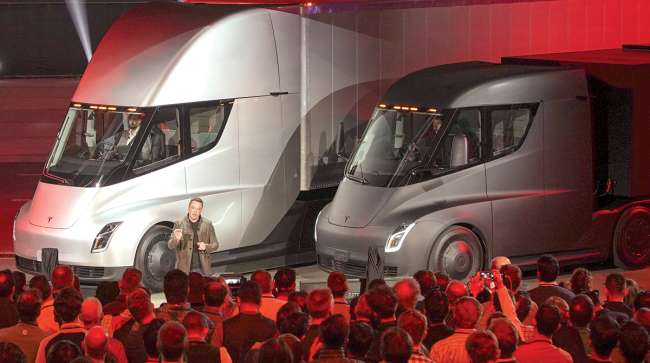Rollout of Active Steering in Trucking Draws Near

Active steering is steadily moving beyond the prototype stage and is expected to become available in commercial trucks within the next couple of years.
The rollout of automated steering should occur in stages, beginning with lane-keeping assistance and lane-centering capabilities, which could reach the market by 2020.
As original equipment manufacturers and suppliers ready these technologies for production, they will need to prove to fleet executives that the safety and performance improvements are worth the added cost.
Automated lane keeping will offer a clear benefit to fleets by preventing accidents caused by unintentional lane departures, said Kent Jones, vice president of sales and business development for commercial steering systems at ZF Group.
Enabling the truck to steer itself represents a significant step forward from today’s safety systems, which rely on audible warnings to alert the driver when the truck drifts out of its lane.
“It’s not going to let the driver go back in the cab and take a nap, but it has shown to make these truckers safer,” Jones said.
Bosch recently demonstrated how its Servotwin steering system can enable automated lane centering, which maintains the truck in its lane with the help of cameras.
“I think this is the kind of system the market is willing to pay for,” said Jason Roycht, vice president of Bosch’s commercial vehicle and off-road business unit in North America.
Key Component
Active steering also is an essential element of autonomous driving.
Companies such as Uber Technologies Inc. are developing autonomous driving systems for heavy-duty trucks, but adoption will depend on factors such as the emerging regulatory framework and public acceptance of the technology.
Established suppliers of braking and active-safety systems are lining up to support OEMs as they ready their launches of automated steering-equipped trucks.
Besides licensing technology or forming partnerships, some suppliers have turned to acquisitions to expand their active-steering capabilities.
Major deals include Wabco Holdings’ purchase of R.H. Sheppard Co. in 2017 and Knorr-Bremse Group’s acquisition of Tedrive in 2016. Knorr-Bremse is the parent of Bendix Commercial Vehicle Systems.

Virtual reality demonstration by ZF at North American Commercial Vehicle Show in Atlanta in September. (Seth Clevenger/Transport Topics)
ZF Group’s merger activity has been especially aggressive, including its monumental purchase of automotive component supplier TRW in 2014 for $13.5 billion, as well as its purchase of a 40% stake in Ibeo in 2016, giving it access to lidar and other sensor technologies for autonomous driving.
There is a lot of expertise out there, “and taking advantage of that through acquisition is one way suppliers grow their automated steering business and how those we purchase grow their businesses,” said Fred Andersky, director of customer solutions at Bendix.
The technologies suppliers have gained through mergers and acquisitions have helped them step up the automated-steering capabilities they can offer OEMs as third-party alternatives.
Meanwhile, technology companies and startups seeking to offer autonomous driving systems for trucks have served to disrupt the commercial vehicle space — even though they have yet to launch products commercially.
“The increasing investment of traditional technology companies in heavy-duty truck systems has expanded the available options as we decide whether partnership or in-house development will yield the best outcome for our product line,” said Keith Brandis, vice president of product planning for Volvo Trucks North America.
Uber’s Advanced Technologies Group and Google sister company Waymo have begun testing of automated trucks capable of driving themselves with no input from the driver under certain conditions. Among the startups, Embark has shown a working prototype of a self-driving commercial truck and Starsky Robotics is developing remote-controlled commercial vehicles.
Musk Throws Hat Into Ring
Tesla Inc. also has entered the race to develop automated driving systems for trucks. Co-founder and CEO Elon Musk, who unveiled the company’s all-electric Class 8 truck in November, said the vehicle will come standard with lane-centering technology when it is scheduled to enter production in 2019.
Despite the lack of details Tesla has provided about its Semi model, major fleets such as UPS Inc., PepsiCo, Anheuser-Busch, Sysco and Wal-Mart have placed orders for the vehicle.
Ultimately, the development of active steering technology will need to generate practical advances in safety and driving performance, ZF’s Jones said.

Jones
“The OEMs are doing the development and the suppliers are assisting them for many systems, but in the end, what brings value to the operator?” Jones said. “In some cases, there should be a good economic payback, but what that will be remains to be seen. Regardless, it will be a really exciting space to be in during the next five years or so.”
The development of automated steering systems is divided between OEMs that integrate electric steering, cameras and radar in house and those that rely instead on third parties for their development.
“The increased levels of automation require a deeper integration into the vehicle controls and architecture to ensure safe implementation and safe operation, even in the case of single component failure or signal loss,” Bosch’s Roycht said. “This integration is a challenge that the OEMs and suppliers must address together. Lastly, the incremental cost for such systems needs to have a positive value equation for the truck owner.”
Many manufacturers already have introduced automated steering features in their passenger cars.
OEMs that build cars and trucks, such as Volkswagen and Daimler, the parent of Mercedes-Benz Cars, could apply their development experience to their truck businesses.
Suppliers with pre-existing business with carmakers for automated steering also stand to benefit.
ZF’s Jones said the company has been able to leverage the “very high cost” of developing automated steering for cars by transferring that technology to trucks.
A case in point is an active steering concept ZF will demo at the upcoming Consumer Electronics Show, scheduled for Jan. 9-12. This systems for highly automated vehicles features a steering wheel with a 7-inch touch screen with gesture control capabilities.
“This gesture control concept for cars is definitely is something that could eventually translate into commercial trucks,” Jones said.
However, porting radar and sensor systems for automated steering from cars to trucks presents component design challenges. This is due to differences in the software stacks for the two different vehicle types, as well as structural differences such as height and the more severe duty cycles of trucks compared with those of cars, Wabco Holdings Americas President Jon Morrison said.

Morrison
“But overall, while there are certainly things to take into consideration for trucks that are not in a car, we are able to take the technology we develop for a car and apply it to the truck world, which is really helpful,” Morrison said.
Automated steering encompasses a wide range of applications, and the timing of the rollout of these capabilities will thus vary depending on their complexity.
Lane correction and centering systems should become widely available soon. This is largely explained by how they are relatively straightforward to design and implement, and rely on tried-and-tested technologies such as actuators, machine steering and camera sensors to work. Automated driving, on the other hand, can involve machine learning, artificial intelligence and high-level sensor and mapping capabilities, which must be perfected before wide-scale commercial use can begin.
However, advanced self-driving capabilities could come a lot sooner than OEMs and some suppliers say they will, said Richard Bishop, president of Bishop Consulting.
Some proponents say the technology already exists that could allow trucks to travel autonomously at low speeds in traffic jam conditions or on open highways, enabling the driver to rest or to do other things as the truck pilots itself.
Embark, which has partnered with Peterbilt Motors Co. after securing $15 million from investors to develop machine-driven trucks in 2017, has debuted working truck prototypes it said can pilot themselves over long stretches of highways in states such as Texas and Arizona.
Embark recently used its automated driving system to transport Frigidaire refrigerators 650 miles from Texas to California.
“These Level 4 self-driving capabilities could be available commercially within two years,” Bishop said. “The technology is mostly ready.”
Daimler Trucks North America unveiled its semi-autonomous Inspiration concept truck in 2015, but the company does not expect hands-off driving to become available in commercial trucks within five years.
“Suppliers can offer the necessary componentry and Daimler has the software, but technological, regulatory and societal hurdles remain,” said Derek Rotz, director of advanced engineering for Daimler Trucks North America. “For the foreseeable future in the near term, drivers’ hands will remain on the wheel.”
Even seemingly mundane systems such as automatic parking, a common feature in cars today, can pose design challenges. This helps to explain why automated steering capabilities will become available in trucks in incremental stages during the next few years, Bendix’s Andersky said.
“Overall, I think there is some overoptimism in the industry for when some of these things can come out,” he said.


